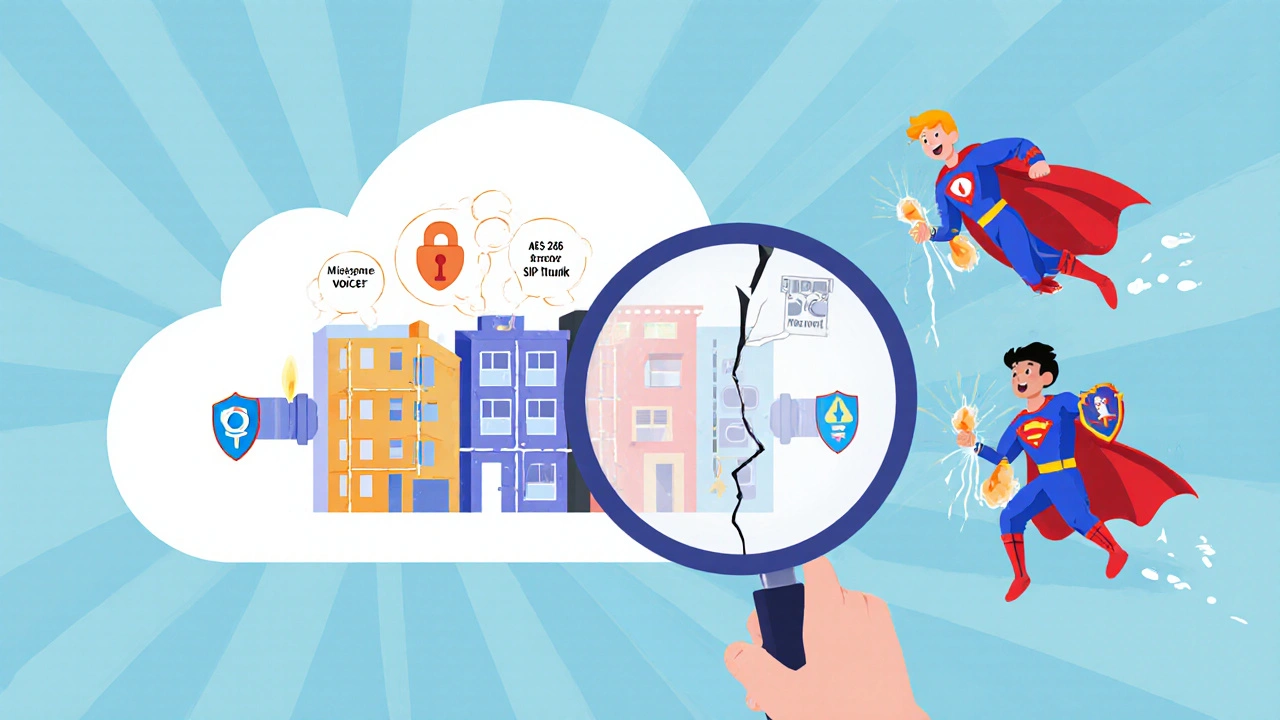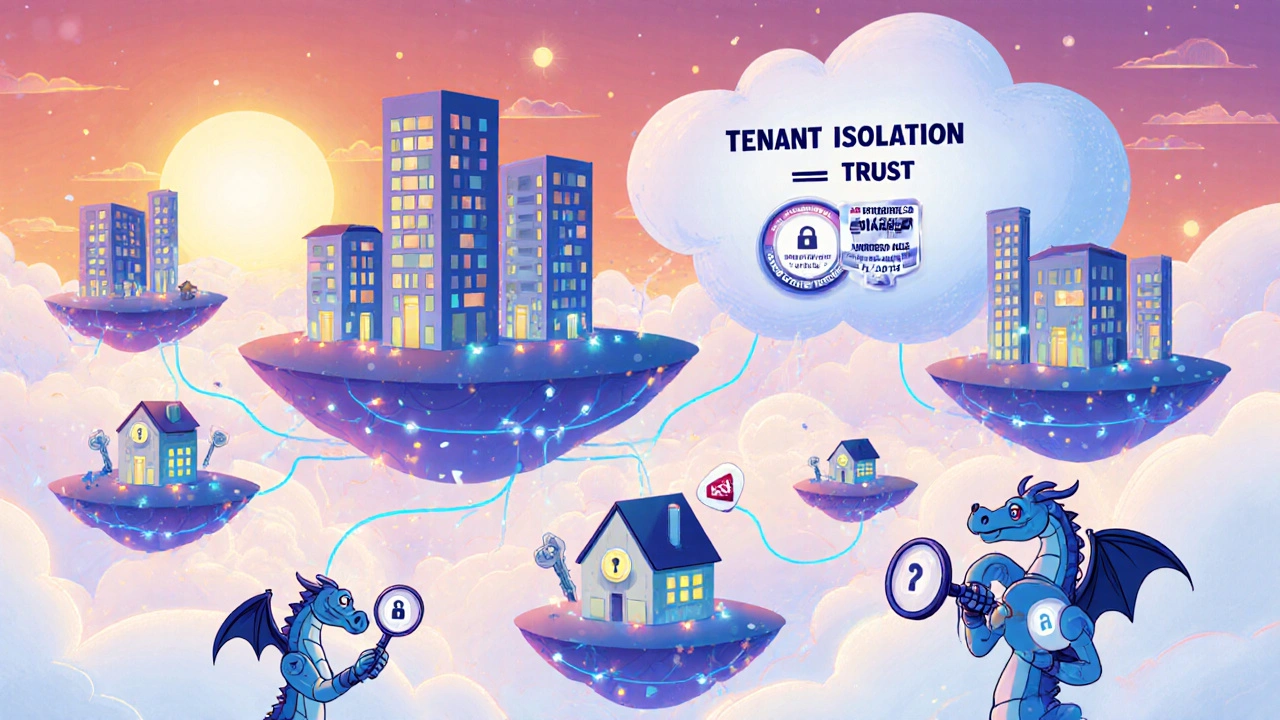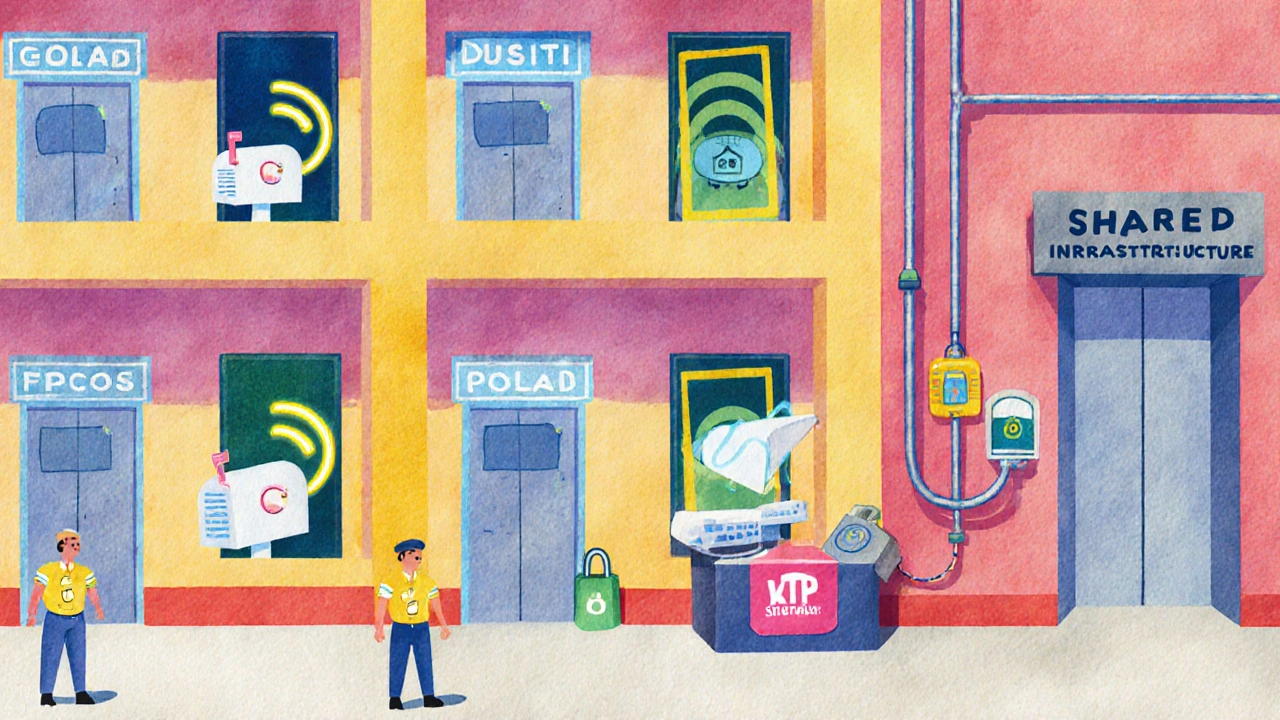When you use a cloud-based phone system, you might assume your calls, voicemails, and call logs are locked away safely-just for your company. But what if they weren’t? What if another business using the same cloud system could accidentally-or even intentionally-access your voice data? That’s not science fiction. It’s a real risk in shared cloud VoIP environments. And the only thing standing between your sensitive conversations and a data leak is shared tenant isolation.
What Exactly Is Tenant Isolation in Cloud VoIP?
Think of a cloud VoIP platform like an apartment building. Each tenant (a company) has their own unit, their own mailbox, their own keys. But the building’s wiring, elevator, and security system are shared. Tenant isolation ensures that even though you’re all on the same infrastructure, your voice traffic, call records, and admin settings never mix with someone else’s. Without proper isolation, a misconfigured API, a flawed network setting, or a software bug could let one company hear another’s calls, see their call logs, or even change their phone settings. This isn’t theoretical. In 2023, a major financial services firm discovered that call detail records from one tenant were appearing in another tenant’s reporting dashboard due to a SIP trunking misconfiguration. That’s not a glitch-it’s a breach waiting to happen.How Do Cloud VoIP Providers Actually Separate Tenants?
There’s no single magic bullet. Isolation is built in layers. Here’s how the top providers do it:- Network Isolation: Each tenant gets its own virtual network-usually a VPC (Virtual Private Cloud) or VLAN. This means your voice packets (RTP streams) never travel on the same network path as another company’s. InfoQ’s 2024 serverless security framework confirms this is non-negotiable for any serious provider.
- Data Encryption: All voice data must be encrypted end-to-end with AES-256, and each tenant gets their own unique encryption key. This isn’t optional. PCI DSS Section 4.1 requires it for any system handling voice-based payments. Even if someone intercepts your call data, they can’t decrypt it without your tenant’s key.
- Containerization: Most modern platforms use Docker or Kubernetes to run each tenant’s services in isolated containers. This prevents one tenant’s software from crashing or spying on another’s. As of 2024, 63% of cloud VoIP providers rely on container-based isolation, according to Serverion’s infrastructure survey.
- Role-Based Access Control (RBAC): Permissions are strict. You’ve got system admins, tenant admins, user admins, and end users. A user in Company A can’t access Company B’s admin panel-even if they’re logged into the same platform. RBAC structures are typically four-tiered and audited quarterly.
- API Gateways: Every API call must be authenticated with tenant-specific OAuth 2.0 tokens. RingCentral’s implementation reduced cross-tenant API breaches by 83% compared to platforms using shared API keys, per a 2023 ESG Lab study.
Multi-Tenant vs. Single-Tenant: The Real Trade-Offs
You might think, “Why not just go single-tenant? Then there’s no risk.” But that’s not the full picture. Single-tenant solutions-like Five9’s Enterprise Cloud-give you your own physical servers, dedicated bandwidth, and zero risk of neighbor interference. Sounds perfect, right? But they cost 35-45% more. A 100-user system might run $40 per user/month versus $20 for multi-tenant. Implementation takes 8-12 weeks instead of 2-4. Multi-tenant systems win on cost, speed, and scalability. Twilio handled a 500% spike in call volume for a major airline during the holidays without a hiccup-something single-tenant setups struggle with. But they come with hidden complexity. In the 2023-2024 period, 22% of cloud VoIP security incidents were tied to poor tenant separation, according to the Cloud Security Alliance. Here’s the kicker: if you’re in healthcare (HIPAA), finance (FINRA), or government, you might still need single-tenant. A 2024 Chilmark Research survey found healthcare orgs prefer single-tenant by 27% because of physical separation requirements. But for most mid-sized businesses? Multi-tenant with strong controls is not just good enough-it’s better.
What Happens When Isolation Fails?
Failure isn’t always dramatic. Sometimes it’s quiet. A user in Tenant A accidentally gets access to Tenant B’s call recordings because a misconfigured S3 bucket was shared between tenants. Or a vulnerability in the shared call analytics engine lets someone reconstruct another tenant’s call patterns. In 2023, a Reddit thread on r/sysadmin documented a case where a misconfigured SIP trunk allowed one tenant to see another’s call detail records. No one noticed for weeks. That’s the danger: isolation flaws often hide in plain sight. The Cloud Security Alliance’s 2024 Incident Report found that 41% of multi-tenant VoIP platforms failed to keep tenant-specific audit logs-something GDPR Article 30 requires. Without those logs, you can’t prove you didn’t leak data. And if you’re audited? You’re in trouble. Even hardware isn’t safe. Jeremiah Grossman of WhiteHat Security warned in early 2024 about “Spectre-like” CPU cache attacks that could let one tenant snoop on another’s voice packets through shared processor resources. It’s a low-probability, high-impact threat-and it’s real.How to Pick a Provider That Actually Protects You
Not all cloud VoIP providers are equal. Here’s what to demand:- Ask for SOC 2 Type II certification. 89% of enterprise buyers now require it. It’s proof they’ve been audited for security controls.
- Check if they offer tenant-specific encryption keys. If they say “we encrypt everything,” push back. Ask: “Do we get our own key?”
- Require API key isolation. No shared API endpoints. Each tenant must have unique, revocable tokens.
- Verify audit log separation. Can you export logs that show only your tenant’s activity? If not, walk away.
- Look at user reviews. On G2 Crowd, 84% of enterprise users say tenant isolation is “critical” to their decision. RingCentral scores 4.6/5 for isolation-above the category average of 4.2. TrustRadius shows 63% of negative reviews mention “data leakage concerns.”

Implementation Tips: Don’t Set It and Forget It
Even the best platform fails if you misconfigure it. Most IT teams need 3-6 months to fully master tenant isolation settings, according to the Cloud Communications Alliance. Here’s how to get it right:- Start with identity federation. Link your company’s Active Directory or Okta to the VoIP system. Never use local usernames.
- Map out your RBAC roles. Who can change call routing? Who can export call logs? Limit access tightly.
- Test for leakage. Run a penetration test. Try to access another tenant’s data using your credentials. If you can, the provider’s isolation is broken.
- Enable automated configuration checks. Zoom’s 2023 security update included tools that auto-detect misconfigured SIP settings. Use them.
- Monitor logs daily. Look for unusual API calls, unexpected logins, or data exports. Set alerts.
The Future: Zero Trust, AI, and Hardware-Enforced Isolation
The game is changing fast. Microsoft Teams now offers “Tenant Isolation Zones” with hardware-level separation for financial and government clients. RingCentral launched “Voice Data Sovereignty” controls in April 2024, letting you choose exactly where your voice data is processed-critical after GDPR’s Schrems II ruling. By 2025, 80% of major providers plan to use AI to detect abnormal behavior-like a user suddenly downloading 10,000 call recordings from another tenant. That’s not just logging. That’s real-time threat blocking. NIST is even working on Special Publication 800-227, a new standard for multi-tenant communications security, due out late 2024. If your provider isn’t preparing for it, they’re falling behind.Final Reality Check
Shared tenant isolation isn’t a feature. It’s the foundation. If your cloud VoIP provider can’t clearly explain how they separate your data from others, they’re not ready for enterprise use. You’re not paying for a phone system-you’re paying for trust. And trust is built on layers of technical control, not marketing slogans. The market is consolidating around providers who can prove isolation works. Gartner says platforms without strong tenant controls face 65% higher customer churn. That’s not a risk you can afford to ignore.Can two companies on the same cloud VoIP system accidentally hear each other’s calls?
Yes-if tenant isolation is poorly implemented. Voice data (RTP streams) should be encrypted and routed through separate virtual networks. But if encryption keys are shared, SIP trunks are misconfigured, or network segmentation is weak, call data can leak. There have been documented cases where call detail records from one tenant appeared in another’s dashboard due to API or configuration errors.
Is multi-tenant VoIP secure enough for HIPAA compliance?
Yes, but only if the provider has specific controls. HIPAA requires encryption, access logs, and business associate agreements. Leading platforms like Vonage and RingCentral offer HIPAA-compliant multi-tenant setups with tenant-specific encryption, audit trails, and RBAC. But you must confirm they’ve signed a BAA and that their isolation controls meet NIST 800-53 standards. Never assume compliance-it must be verified.
What’s the difference between tenant isolation and network segmentation?
Network segmentation is just one layer. It keeps traffic separate at the IP level using VLANs or VPCs. Tenant isolation is the full picture: it includes segmentation, encryption, access controls, API security, containerization, and audit log separation. You can have segmentation without full isolation-but you can’t have isolation without segmentation.
Why do some companies still choose single-tenant VoIP?
Single-tenant solutions offer complete physical and logical separation, which appeals to highly regulated industries like healthcare, finance, and government. They eliminate any theoretical risk of cross-tenant data exposure. But they cost 35-45% more and take longer to deploy. Most businesses don’t need that level of isolation-unless they’re subject to strict physical data sovereignty laws.
How can I test if my VoIP provider’s tenant isolation is working?
Ask your provider for a penetration test report. If they don’t have one, hire a third party. Try logging in as a user from another tenant (if allowed) and see if you can access their call logs, recordings, or settings. Test API endpoints with invalid tenant tokens. Check if audit logs show only your tenant’s activity. If you can access anything outside your tenant, the isolation is broken.
Are there any free or open-source multi-tenant VoIP platforms with good isolation?
Open-source options like FusionPBX exist and have active communities (over 45,000 users), but they require deep technical expertise to secure properly. Most lack built-in tenant isolation controls like RBAC, encrypted key separation, or automated audit trails. They’re not recommended for businesses handling sensitive data unless you have a dedicated security team. Commercial platforms with SOC 2 certification are far safer for most organizations.
